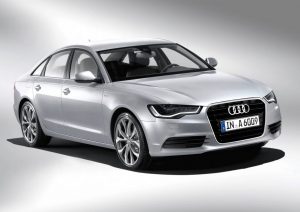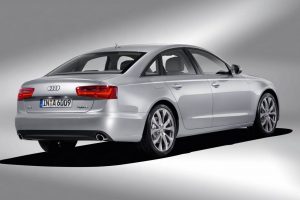Recalls: Audi C7 A6
Overview
Manufacturers, or importers, issue recalls for defects or faults which have the potential to cause injury. Generally, manufacturers will inform the original buyers if their vehicle is subject to a recall and of the steps required to remedy the defect or fault. Please note that the recalls below (if any) are for Australian-delivered vehicles only. Furthermore, the number of recalls should not be taken as an indication of a model’s reliability or its safety more generally.
Recalls: Audi C7 A6
Audi C7 A6 3.0 TDI: engine oil in brake servo
In August 2014, a recall was issued for Audi C7 A6 vehicles with 3.0-litre turbo-diesel engines. In these vehicles, engine oil may enter the brake servo via the vacuum lines. If this occurred, the diaphragm in the brake servo could rupture and cause the brake servo to fail. As a result, stopping distances may be increased, posing an accident hazard to occupants and other road users (PRA 2014/14280).
2011-12 Audi C7 A6 3.0 TFSI: potential fuel leak
In January 2015, a recall was issued for Audi C7 A6 models with the 3.0 TFSI engine that were manufactured from April 2011 up to and including April 2012. In these vehicles, a fuel leak may occur at the connection between the fuel rail and the injector. If this occurred, the owner may detect a fuel smell from the engine compartment and leaking fuel could pose a fire hazard in the presence of an ignition source. As part of the recall, the fuel rail was to be replaced and a reinforced retaining bracket fitted (PRA 2015/14530).
Audi C7 A6: diesel engine emissions
In October 2015, Audi Australia issued a recall for Audi C7 A6 vehicles with 2.0-litre EA189 diesel engines that were available for sale from 2011 to 2015. According to the recall notice, the exhaust emissions for these vehicles ‘may not meet regulatory requirements when the affected vehicle is driven under normal conditions’ (see ‘Diesel engines: NOx emissions “defeat device”‘, below). For the 2.0-litre EA189 engine, a software update will be introduced which takes advantage of improved simulation of air currents inside the air intake system. Volkswagen aims to implement the software update from January 2016; the labour time for installing the updated software is around half an hour. Owners could determine whether their vehicle was included in the recall by using a VIN checking tool at audi.com.au (PRA 2015/14956).
Audi C7 A6 with MMI Plus: Google Earth content may display while driving
In October 2015, a recall was issued for Audi C7 A6 vehicles that were fitted with Audi’s navigation Multi Media Interface (MMI) Plus. In these vehicles, the MMI was incorrectly coded during production such that internet content from Google Earth would be displayed while the vehicle was moving. The display of Google Earth (images and text) while the vehicle was moving could potentially distract the driver and lead to an accident (PRA 2015/14958).
2017 model year Audi C7 A6: airbags and pre-tensioners may not deploy as intended
In March 2017, a recall was issued for 2017 model year Audi C7 A6 and A6 Avant vehicles. In these vehicles, irregularities in the mix ratio of the igniting agent in some airbag units or seatbelt pre-tensioners could lead to the airbags or belt pre-tensioners not deploying in the event of a collision. As such, the risk of injury for the front occupants of the vehicle was increased. For the VINs of the recalled vehicles, please see PRA 2017/15964.
2011-16 Audi C7 A6 2.0 TFSI: coolant pump may catch fire
In May 2017, a recall was issued for Audi C7 A6 vehicles that had 2.0-litre turbocharged petrol engines (Audi’s ‘2.0 TFSI’) and were manufactured from 2011 to 2016. In these vehicles, foreign particles in the coolant could cause a blockage in the additional coolant pump and cause the pump to overheat. In isolated cases, the overheated coolant pump could catch fire if it were not repaired. For the VINs of the recalled vehicles, please see PRA 2017/16068.
2011-17 Audi C7 A6 2.0 TFSI: overheating of additional coolant pump
In June 2018, a recall (campaign number 19N3) was issued for 2011-17 Audi C7 A6 and A6 Avant 2.0 TFSI vehicles. In these vehicles, moisture could enter electronic components, causing overheating and failure of the additional coolant pump. The overheating could cause localised smoulder damage to the components which, in some cases, could cause the vehicle to catch fire. For the VINs of the recalled vehicles, please see PRA 2018/16842.
2014 Audi C7 A6: electrical connector for auxiliary heater element
In May 2019, recall campaign 82C1 was issued for Audi C7 A6 vehicles that were manufactured between July 2014 and October 2014. In these vehicles, the auxiliary heater element in the air conditioner may fail due to an electrical connector that had not been plugged in correctly. Overheating in the area of the connectors could cause smoulder damage and, potentially, a fire. For the VINs of the recalled vehicles, please see PRA 2019/17547.
2012-17 Audi C7 A6: restricted oil supply to turbos and loss of power
In August 2022, recall campaign 21H7 was issued for 2012-17 Audi C7 A6 vehicles. Due to a manufacturing issue, the oil supply in the oil strainer to the turbochargers may become clogged and affect engine operation. This could cause a loss of power while driving and this condition increased the risk of a collision and injury to vehicle occupants, road users and bystanders. For the VINs of the recalled vehicles, please see REC-005488.
Problems and faults: Audi C7 A6
Overview
This section identifies potential problems, causes and fixes based on the experiences of owners and repairers, online sources and technical service bulletins. This information is provided solely for reference purposes and AustralianCar.Reviews recommends that only properly qualified persons carry out repairs or modifications. Furthermore, the number of items below should not be taken as an indicator of a model’s reliability or the frequency with which they may occur.
To report a problem or fault to the AustralianCar.Reviews team, please use the Contact Us form. Note that AustralianCar.Reviews does not offer advice on automotive problems or disputes; such enquiries will not receive a reply. For vehicles purchased from dealers after 1 January 2011, please see our Australian Consumer Law fact sheet.
Audi C7 A6 3.0 TFSI: rattling noise from timing chain on start-up
In 27 April 2016, Audi issued Technical Service Bulletin 15 16 28 2039995/2 for 2011-15 model year Audi C7 A6 3.0 TFSI vehicles. In these vehicles, rattling noises may be heard from the timing chain drive (at the back of the engine) for around 1-3 seconds after the first engine start of the day. According to the bulletin, these noises were caused by one of the upper chain tensioners, but did not lead to damage. To fix, both upper chain tensioners of bank 1 and bank 2 were to be replaced with ‘optimised’ chain tensioners. The part numbers were as follows –
- Chain tensioner for bank 1: part number 06E109218AJ; and,
- Chain tensioner for bank 2: part number 06E109217AH.
2011-17 Audi C7 A6: rattle noise from front right dash panel
In July 2016, Audi issued Technical Service Bulletin 97 16 56 2042450/2 for 2011-17 model year Audi C7 A6 vehicles. According to the bulletin, these vehicles may exhibit a rattling noise from the front right dashboard panel when driven with light acceleration between 25 km/h and 40 km/h. This rattling noise was attributed to a locating tab for the starter motor wiring harness that could vibrate. To fix,
- The bracket for the starter motor wiring harness was to be removed;
- A three-inch piece of fabric adhesive tape was to be wrapped around the locating tab to prevent it from moving freely. The tape was to be wrapped around the tab approximately four times so that it would fit firmly in its hole; and,
- The bracket was to be re-installed.
Audi A6 V6 diesel engine: NOx emissions “defeat device”
Audi C7 A6 vehicles powered by 3.0-litre diesel V6 engines (engine codes: CDUC/CDUD/CRTE/CGQB) that were available for sale from 2011 have software in the electronic control module (ECM) that can sense – via sensors measuring the position of the steering wheel, vehicle speed, the duration of the engine’s operation and barometric pressure – when the vehicle is undergoing emissions testing. The ECM then operates in a low NOx “temperature conditioning” mode to satisfy emissions standards.
At exactly one second after the completion of the initial phases of the standard test procedure, the software immediately switches to a “normal mode” and changes a number of operating parameters that increased NOx emissions. In other tests where the vehicle did not experience driving conditions similar to the start of the emissions testing procedure, the emissions were higher from the start, consistent with the operation and existence of a “normal mode”.
The software on these vehicles constitutes a “defeat device” since it is an Auxiliary Emissions Control Device (AECD) designed to circumvent emissions testing. Volkswagen has admitted that all its 3.0-litre turbo-diesel engines from ‘model years’ 2009 through to 2016 have defeat devices.
Audi A6 I4 diesel engine: NOx emissions “defeat device”
Australian-delivered Audi C7 A6 vehicles powered by 2.0-litre diesel engines that were available for sale from 2011 to 2015 had software in the electronic control module (ECM) that could sense – via sensors measuring the position of the steering wheel, vehicle speed, the duration of the engine’s operation and barometric pressure – when the vehicle was undergoing emissions testing. The ECM would then run a ‘dyno calibration’ to produce lower nitrous oxide emissions during testing. At all other times, the ECM would run a separate ‘road calibration’ which reduced the effectiveness of the emission control system, specifically the selective catalytic reduction (SCR) or the lean NOx trap.
Based on testing conducted by the EPA and the California Air Resources Board (CARB), NOx emissions for the ‘road calibration’ were 10 to 40 times higher than US standards – this led the United States Environmental Protection Agency (EPA) to issue a notice of violation under the Clean Air Act. As a result, these vehicles did not meet the environmental standards claimed by Audi.




